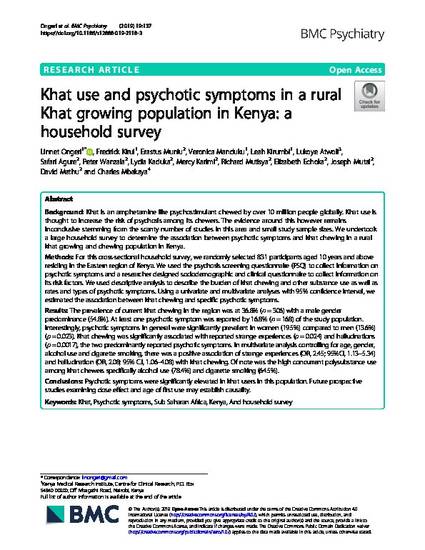
Background:Khat is an amphetamine like psychostimulant chewed by over 10 million people globally. Khat use is thought to increase the risk of psychosis among its chewers. The evidence around this however remains inconclusive stemming from the scanty number of studies in this area and small study sample sizes. We undertook a large household survey to determine the association between psychotic symptoms and khat chewing in a rural khat growing and chewing population in Kenya.
Methods:For this cross-sectional household survey, we randomly selected 831 participants aged 10 years and above residing in the Eastern region of Kenya. We used the psychosis screening questionnaire (PSQ) to collect information on psychotic symptoms and a researcher designed sociodemographic and clinical questionnaire to collect information on its risk factors. We used descriptive analysis to describe the burden of khat chewing and other substance use as well as rates and types of psychotic symptoms. Using a univariate and multivariate analyses with 95% confidence interval, we estimated the association between khat chewing and specific psychotic symptoms.
Results:The prevalence of current khat chewing in the region was at 36.8% (n = 306) with a male gender predominance (54.8%). At least one psychotic symptom was reported by 16.8% (n = 168) of the study population. Interestingly, psychotic symptoms in general were significantly prevalent in women (19.5%) compared to men (13.6%) (p = 0.023). Khat chewing was significantly associated with reported strange experiences (p = 0.024) and hallucinations (p = 0.0017), the two predominantly reported psychotic symptoms. In multivariate analysis controlling for age, gender, alcohol use and cigarette smoking, there was a positive association of strange experiences (OR, 2.45; 95%CI, 1.13–5.34) and hallucination (OR, 2.08; 95% C.I, 1.06–4.08) with khat chewing. Of note was the high concurrent polysubstance use among khat chewers specifically alcohol use (78.4%) and cigarette smoking (64.5%).
Conclusions:Psychotic symptoms were significantly elevated in khat users in this population. Future prospective studies examining dose effect and age of first use may establish causality.
Available at: http://works.bepress.com/lukoye_atwoli/21/

This work was published before the author joined Aga Khan University.